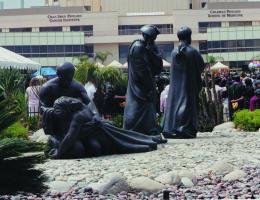We’re Stronger Together
With your help, we can advance education and improve student success in our community.


Click to view "Table 1 Comparison of Basic Terms"
Click to view "Table 2 Comparison of Traditional Student Success Indicators"
Guideline for Academic Definitions
Loma Linda University
PDF FileProgram and Related Terms1
|
Term |
Definition Components |
|
Academic Content |
|
|
Degree Program |
Degree programs regularly have special/unique: • Admissions • Content/curriculum • Diploma 50% difference in curriculum/courses between degree programs Impact on transcript: • Degree noted on transcript
Impact on diploma: • Degree noted on diploma |
|
Concentration |
Curriculum/content must have at least 20% difference in curriculum/courses between other programs in these areas: • Courses, practicum, and/or research
Must have enough qualified faculty (according to professional accreditation standards) to teach/guide a concentration Must have appropriate clinical practice sites, if applicable Impact on transcript: • Concentration may be noted on transcript depending on program’s needs
Impact on diploma: • Concentration may be noted on diploma depending on program’s needs |
|
Specialization |
Adds to the concentration
Impact on transcript: • Specialization not noted on transcript
Impact on diploma: • Specialization not noted on diploma |
1 Any deviation, driven by professional accrediting practice, must be approved by the Provost.
|
Term |
Definition Components |
|
Academic Content |
|
|
Major |
Only undergraduate levels
Impact on transcript: • Major noted on transcript
Impact on diploma: • Major noted on diploma |
|
Minor |
Only undergraduate levels
Impact on transcript: • Minor noted on transcript
Impact on diploma: • Minor noted on diploma |
|
Delivery Methodologies |
|
|
Track |
Schedule options for taking a degree program
Impact on transcript: • Track not noted on transcript Impact on diploma: • Track not noted on diploma |
|
Modality2 |
Modalities for program delivery: • On main campus - 50% or more • Online - 50% or more • Off-campus3 - 50% or more - domestic and international Impact on transcript: • Modality not noted on transcript
Impact on diploma: • Modality not noted on diploma |
2 Whenever an existing program adds a new modality, a full proposal must be approved through the established processes in coordination with the Provost’s Office.
3 Ibid.
1. WHAT DOES LOMA LINDA UNIVERSITY REPORT ON AND DISPLAY STUDENT SUCCESS DATA?
Loma Linda University reports student success data to meet federal and accrediting agency requirements. LLU also reports student success data to allow stakeholders and prospective students to make informed decisions on what they can expect at LLU.
Additionally, LLU’s reporting and displaying of student success data aids program review and supports development of best practices.
2. WHAT TYPES OF STUDENT SUCCESS DATA ARE USED TO DEMONSTRATE SUCCESS IN LLU PROGRAMS?
• Retention Rate
• On-time Graduation Rate (OGR)
• Time-to-Degree
• Board pass rates
• Gainful Employment following program completion
3. HOW ARE STUDENT SUCCESS REPORTS GENERATED?
The Office of Educational Effectiveness develops the reporting templates, and the reports are generated from data stored in the University’s data warehouse.
4. HOW OFTEN IS THE STUDENT SUCCESS DATA UPDATED?
The data is updated daily.
5. WHAT TYPES OF REPORTS ARE AVAILABLE TO EACH SCHOOL?
Each school’s data specialist can determine the number and type of different reports and visualizations. Report access is available at Institutional Research | Loma Linda University (llu.edu) or by contacting the Office of Educational Effectiveness.
6. HOW DOES ONE OBTAIN STUDENT SUCCESS REPORTS?
Please contact your school’s designated data specialist. If they are not able to provide the report, please contact the Office of Educational Effectiveness.
7. IF THERE ARE DISCREPANCIES IN THE DATA DISPLAYED IN A REPORT, WHO SHOULD BE CONTACTED?
The first contact person is the school’s designated data specialist. The data specialist has the responsibility of reviewing reports and working with the Office of Educational Effectiveness (OEE) to reconcile reports. If the data specialist is not able to assist, please contact the OEE.
8. HOW ARE SMALL COHORTS REPORTED?
If a school is disaggregating data for internal use and a small n exists, a “Small n” can be reported in place of actual calculations for the cohort. Please note however that the Integrated Postsecondary Education Data System (IPEDS) requires reporting of data regardless of cohort size.
9. TO WHOM DOES THE STUDENT SUCCESS DATA GENERATED BY PROGRAMS OR SCHOOLS BELONG?
The University owns all student success data regardless of where it is generated.
10. WHEN IS LLU REQUIRED TO REPORT AND/OR PUBLISH NEW DATA ABOUT STUDENT SUCCESS?
The reporting period for updating student success data at WSCUC is May of each year. The reporting deadline for student success data to IPEDS is February 15.
11. WHERE CAN I FIND THE DEFINITIONS OF STUDENT SUCCESS THAT ARE USED ON CAMPUS?
Definitions can be found on the Loma Linda University's student success webpage at llu.edu/sites/llu.edu/files/docs/assessment/Table%201%20%20Comparison%20of%20Basic%20Terms%20for%20IPEDS,%20WASC,%20FED%20AID,%20and%20LLU.pdf
12. CAN WE USE OUR OWN DATABASE AT THE SCHOOL OR DEPARTMENT?
Historically, schools on campus have used various means to accomplish the tracking of data for strategic planning and reporting purposes. LLU Administration and Information Systems have worked toward improving data integrity and streamlining business processes across the campus. Several core software systems have been implemented to enhance the ability of schools to appropriately access data and maintain consistency in reports. Schools are encouraged to utilize these core systems. A best practice would be to utilize the core systems to validate local data integrity and consistency then retire the individual databases once data has been validated.
13. DO WE HAVE A PROTOCOL ON GENERATING REPORTS?
The current protocol specifies that the school’s designated data specialist is the provider for individual school reports. This individual, working with the school’s Dean, fulfills each request. For University-wide data, the Office of Educational Effectiveness generates the report.
14. WHAT ARE THE CONTEXTUAL STUDENT SUCCESS INDICATORS USED ON CAMPUS?
The contextual success indicators include faculty-student contact, co-curricular activities, peer interactions, service activities, and/or spiritual support. Campus leaders continue to explore other types of student success indicators that can be used to describe the impact on the Loma Linda University campus.
Last updated Sept. 2022
With your help, we can advance education and improve student success in our community.